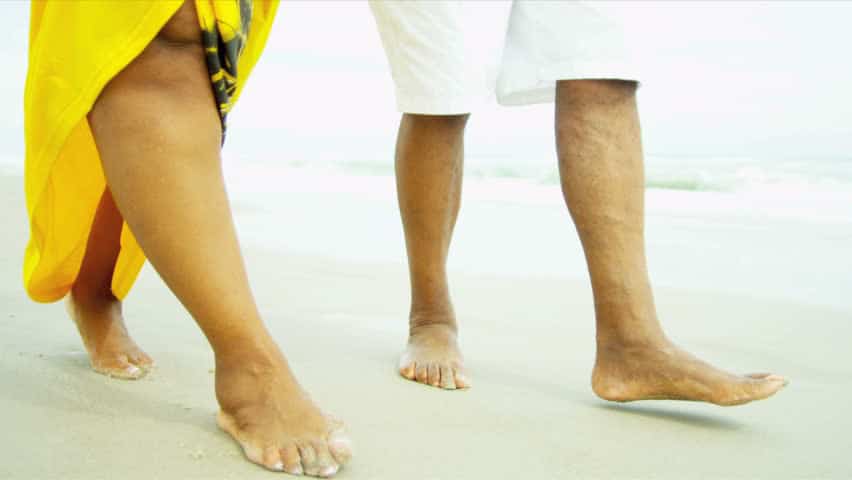It is estimated that over 20 million Americans suffer from venous disease, and an even greater number of patients suffer silently going undiagnosed. Venous disease is a spectrum of findings that usually involves a condition where the vein walls and valves become weakened. The valves stretch and become damaged interrupting normal physiological blood flow. There is a backwards flow of blood (reflux) which increases pressure in the veins. This initiates a vicious cycle of progressive damage to the vein which can ultimately cause chronic venous reflux disease or venous insufficiency.
The physical manifestations of lower extremity venous insufficiency can range from the most common spider and varicose veins to, in extreme cases, skin breakdown and venous ulcers. The venous ulcers can subsequently lead to more serious medical conditions. Vein disease can be easily diagnosed and is treatable even at an advanced stage. The condition is generally covered by most health insurances, including Medicare and Medicaid. Vein disease can get worse if untreated. Incompetent and weakened valves can lead to more prominent varicose veins.
Varicose veins range from smaller “spider veins”, bluish reticular type veins or bulging large prominent varicosities that are on the surface of the legs. They are often a combination of the 3 described manifestations. More importantly for the patient, lower extremity venous insufficiency can cause symptoms that can interrupt normal daily activities and adversely affect the quality of life. Aching painful legs can have a detrimental domino effect to overall health as there is a decrease in physical activity from pain and as a disincentive to exercise or be mobile.
About Venous Disease
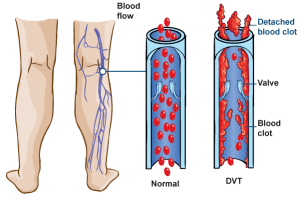 Patients that leave their venous disease untreated are often not able to enjoy the same quality of life or wellness, and are likely to eventually have more serious health issues. As mentioned before, a vicious cycle of derangement occurs as vein disease progresses, varicose veins enlarge become more prominent and valves and veins walls become more damaged. Varicose veins occur only in the lower body and can affect anywhere in the lower half of the body, from the groin down to the ankle.
Patients that leave their venous disease untreated are often not able to enjoy the same quality of life or wellness, and are likely to eventually have more serious health issues. As mentioned before, a vicious cycle of derangement occurs as vein disease progresses, varicose veins enlarge become more prominent and valves and veins walls become more damaged. Varicose veins occur only in the lower body and can affect anywhere in the lower half of the body, from the groin down to the ankle.
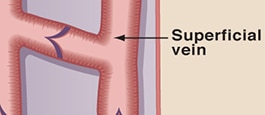
These veins lie just under the skin and drain into perforator veins or deep veins.
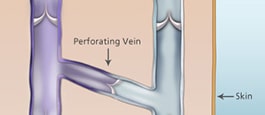
These veins are in between superficial and deep veins, they drain into deep veins.
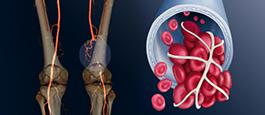
These veins lie inside the muscles and carry most of the blood back to your heart.
With regard to diagnosing and treatment of lower extremity venous insufficiency, we focus on the superficial and perforator veins of the legs. Advances in medical technology have allowed for more eloquent and minimally invasive options for treating lower extremity vein disease. These treatments have largely replaced the more painful and cumbersome hospital-based vein stripping procedures. Many patients that have avoided treatment due to horror stories of painful procedures with long and hard recoveries can now rest easily with these new options.
At Precision we have expertise in all the available minimally invasive techniques. We offer radiofrequency and non-thermal ablation procedures in addition to microphlebectomy. Various smaller varicose and spider veins can also be treated with sclerotherapy (injections). After the initial evaluation, we tailor the correct procedures with patient comfort, safety and maximum effectiveness in mind. To schedule an appointment please call us at 214-382-3200 or complete the form below.

A Solution For Blood Clots
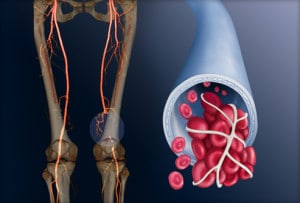
Precision specializes in the diagnosis and treatment of blood clots within both the deep and superficial venous system. Blood clots often cause pain and swelling of the affected limb and can be a life threatening condition. Blood clots rarely dissolve completely on their own and can often lead to permanent damage of the veins and possible life-long side effects called post thrombotic syndrome (PTS).
Although many doctors treat patients for Deep Vein Thrombosis or (DVT) and blood clots, we specialize in comprehensive DVT and blood clot care by offering minimally invasive therapy to potentially remove or dissolve blood clots in the body, especially in the legs. By undergoing an evaluation with one of our experts, you can ensure that your Deep Vein Thrombosis is being treated with the most advanced therapies and techniques available.
Meet Our Expert DoctorsF.A.Q.
Request an Appointment
Our specialists will take the time to answer your questions about venous disease and our advanced procedures. At Precision VIR, we have expertise in all available minimally invasive techniques. After an initial evaluation, we tailor the correct procedures with patient comfort, safety and maximum effectiveness in mind. To schedule an appointment please call us at 214-382-3200 or complete the form below.
Precision VIR serves the DFW area including Dallas, Fort Worth, Carrollton, Richardson, Garland, Mesquite, Highland Park, University Park, Park Cities, Allen, Plano, Frisco, McKinney, Arlington, Irving, Grand Prairie, Flower Mound, Denton, Lewisville and all of North Texas.
This information is not a substitute for professional medical advice. Prior to starting any new treatment or questions regarding a medical condition, always seek the advice of your doctor or other qualified health provider.

